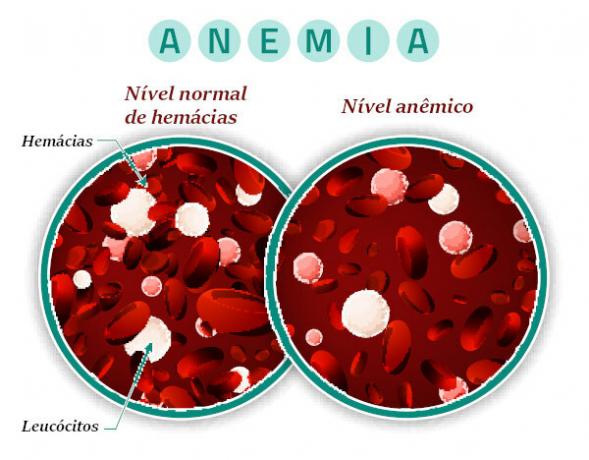Anemia is a condition in which the patient has below normal values of red blood cells or hemoglobin. Contrary to what many people think, anemia is not always the main disease, but a symptom of another health problem. It can be triggered, for example, by the deficiency of some nutrients, like iron or b12 vitamin, losses of blood, infections and neoplasms.An anemic patient usually presents with weakness, tiredness, shortness of breath and palpitations. As types of anemia, we can mention iron deficiency anemia, thalassemia and sickle cell anemia.
Read more: Red blood cells - cells that act in the transport of oxygen
What is anemia?
It is a condition that is characterized by a reduction in the number of red blood cells in the individual's blood or hemoglobin concentration. In these situations, the number of these elements is in a quantity lower than the reference values, which depend on age, sex and the place where the patient lives, since the altitude influences the amount of Red Cells.
anemia
can be triggered by different factors, such as iron deficiency, vitamin B12 deficiency, blood loss, parasitic diseases, neoplasms and chronic diseases. In the world, the most common form of anemia, however, is triggered by iron deficiency, which can occur due to an inadequate diet.
Anemia symptoms
Anemia can generate a series of symptoms, which are related to oxygen deficiency in our patients. fabrics, since the red blood cells are the cells responsible for carrying oxygen in our body. As symptoms of anemia, we can mention:
Tiredness;
Paleness of the skin;
Shortness of breathe;
Somnolence;
Dizziness;
Headache;
Vertigo;
Irritability;
Palpitation;
Pressure fall.
Types of anemia
There are several types of anemia, classified in different ways. Below, we'll introduce some of the most popular ones.
Iron deficiency anemia or iron deficiency anemia
It can be the result, for example, of insufficient iron intake, hemorrhages, menstrual blood loss or may occur as a consequence of infectious parasitic diseases such as worms and intestinal protozooses. This kind of anemia is the most relevant in the world, it is estimated that half of the cases of anemia occur due to iron deficiency. One of the main manifestations of iron deficiency anemia is the pallor in the skin and the mucous membranes.
The treatment will depend on the degree of involvement of the patient. Among the treatments performed are: dietary reeducation, with the recommendation of foods rich in iron, such as dark green meats and vegetables, and foods that improve the absorption of this nutrient, such as rich ones in Vitamin C; iron replacement; and the blood transfusion. If the individual has anemia due to infectious and parasitic diseases, they should also be treated.
Read too: Recommendations for healthy eating
megaloblastic anemia
It's an anemia resulting from a vitamin B12 deficiency and/or folic acid. It can occur due to a diet with little protein, to eating habits, such as veganism, or even due to problems with absorption of these nutrients. Loss of appetite, weakness, tiredness and abdominal pain are some of the symptoms observed in patients with this type of anemia. Your treatment it is done with administration of daily doses of vitamin B12 and folic acid, the amount of them, however, will be recommended by the doctor.
sickle cell anemia

Sickle cell anemia is a genetic condition which is characterized by the production of an abnormal hemoglobin molecule called hemoglobin S. This molecule is responsible for forming elongated red cells resembling a sickle. These red blood cells often cause blockage in the blood vessels, preventing adequate tissue oxygenation. In addition, they have less resistance, breaking more easily. Sickle cell anemia is more common in black individuals.
Like manifestations from sickle cell anemia, we can mention pain in the body, especially bones and joints, due to obstruction of vessels; swelling in hands and feet; and appearance of skin wounds.
O treatment Sickle cell anemia occurs throughout the patient's lifetime and includes, among other approaches, blood transfusion and the use of medication to prevent pain. O Bone marrow transplant it may be indicated in severe cases of the disease, but it is a risky procedure. If you want to deepen your knowledge about this state of health, read: sickle cell anemia.
Thalassemia
It's a kind of hereditary anemia which is characterized by a defect in the synthesis of one or more globin chains that form hemoglobin. Thalassemias are classified according to the affected chain, being the most frequent type alpha and beta. They can cause fatigue, weakness, jaundice (yellowing of the skin and mucous membranes), heart failure, bone deformities and an enlarged liver and spleen. O treatment this type of anemia varies from one case to another, and blood transfusions are even performed in its most severe form.
By Vanessa Sardinha dos Santos
Biology teacher

